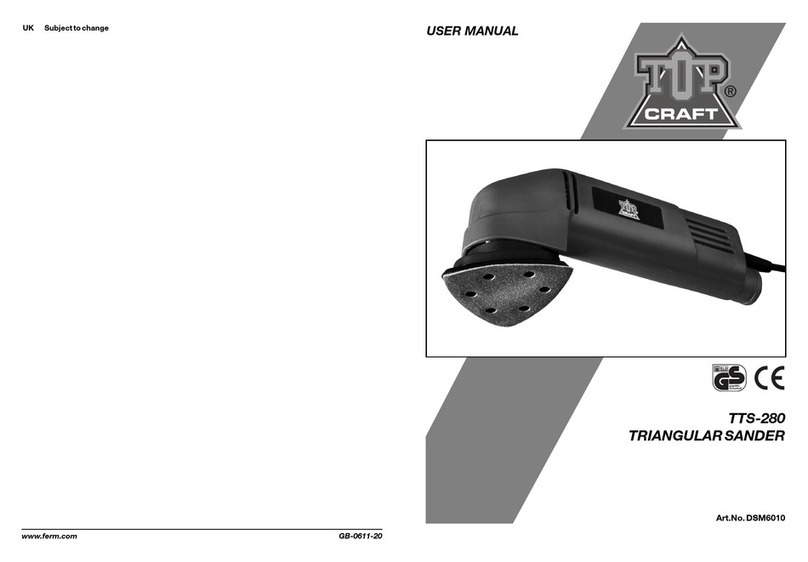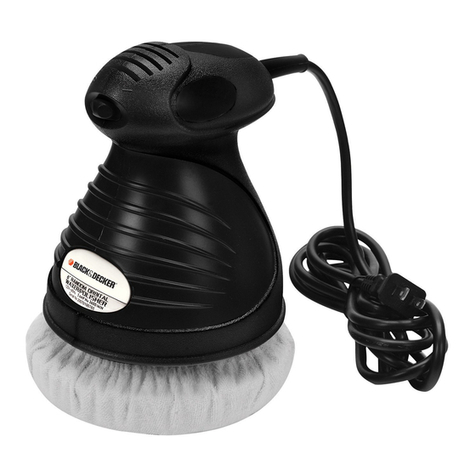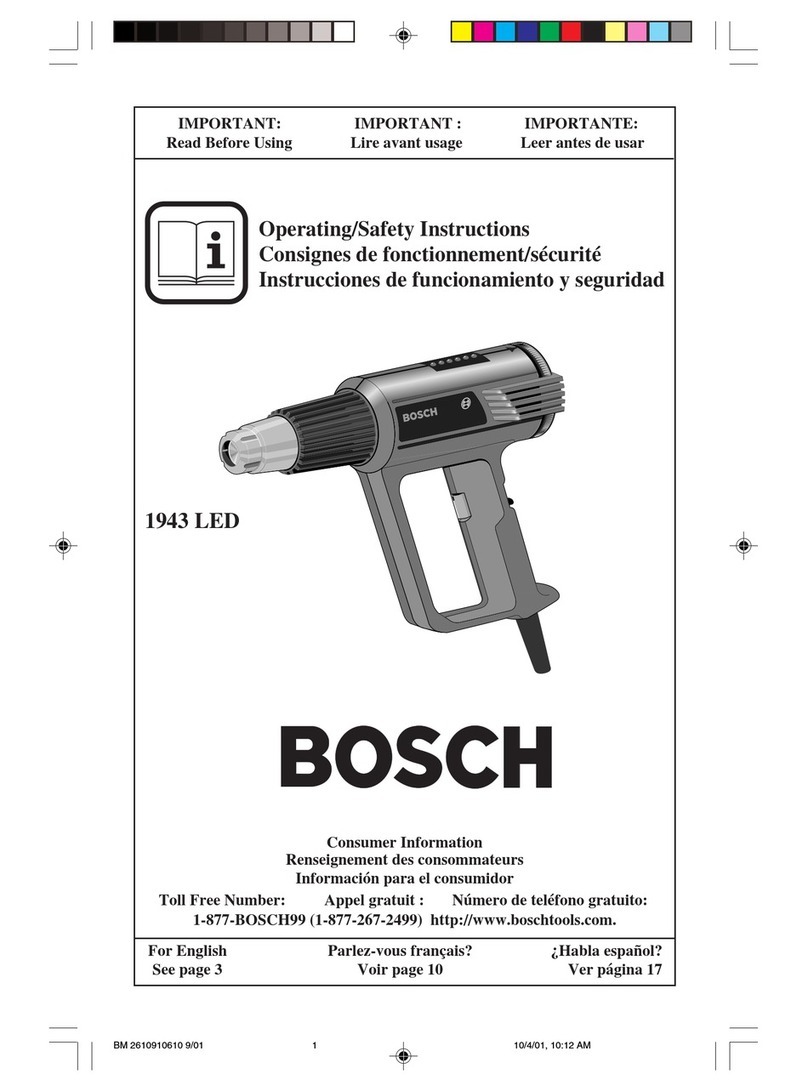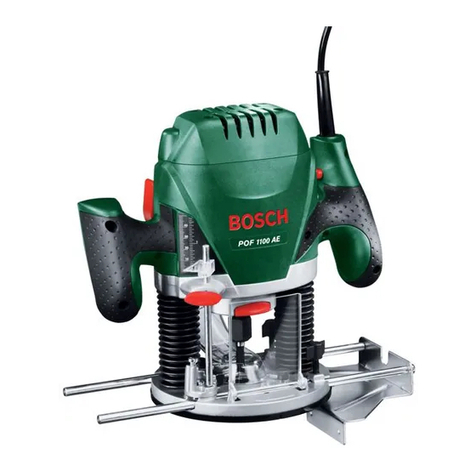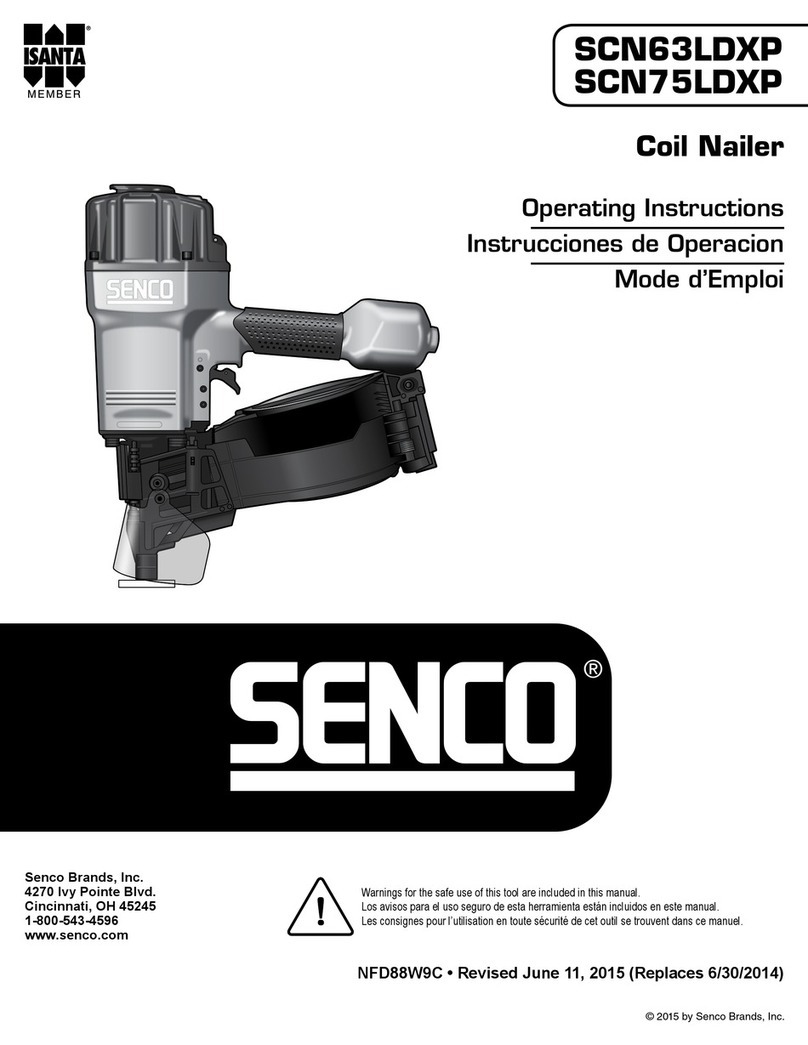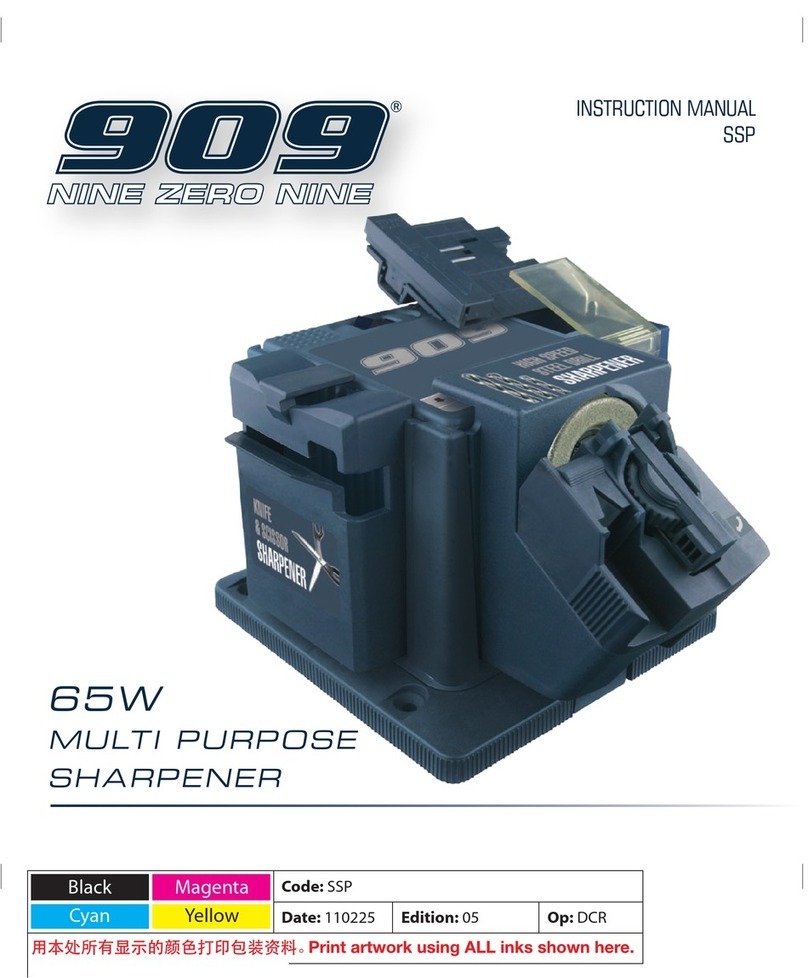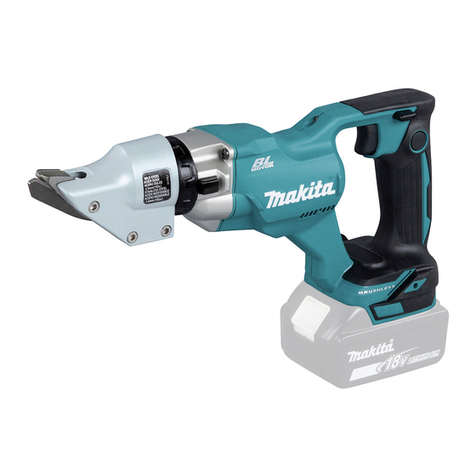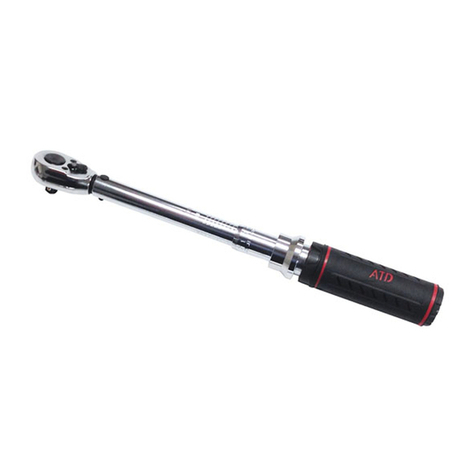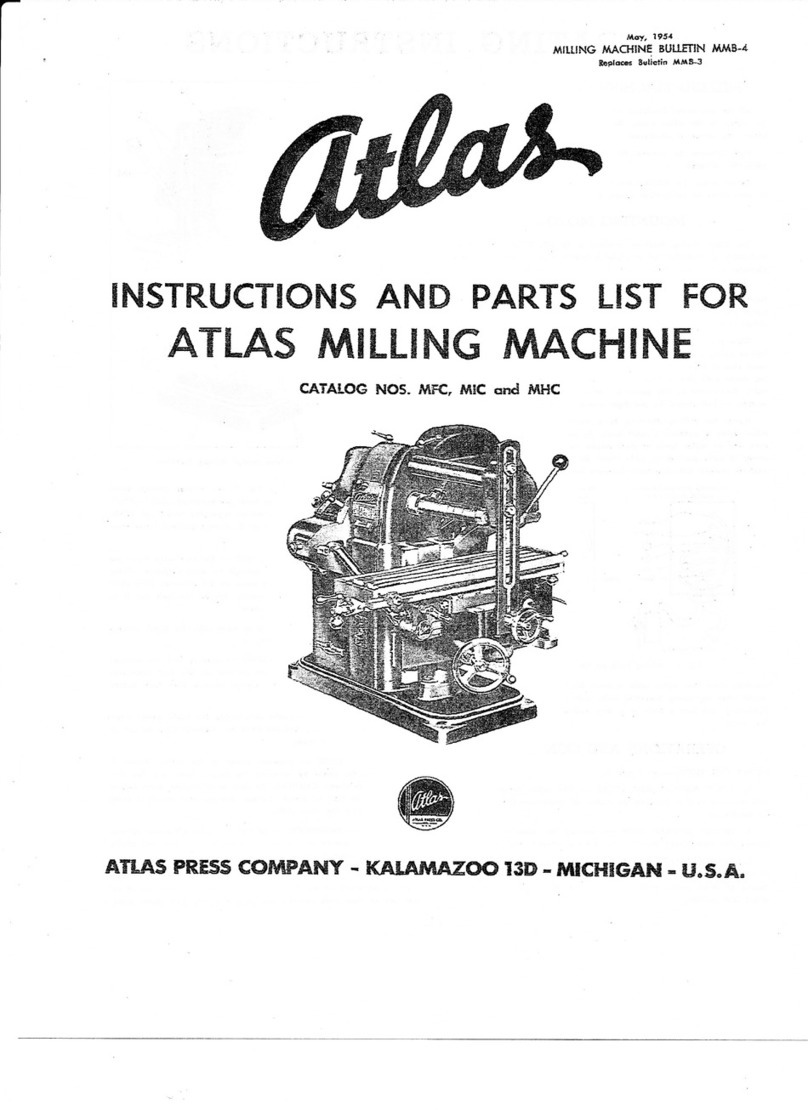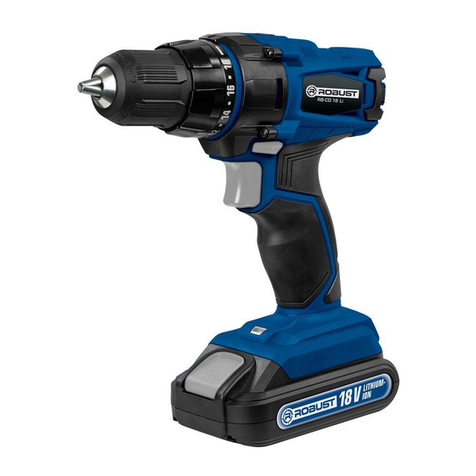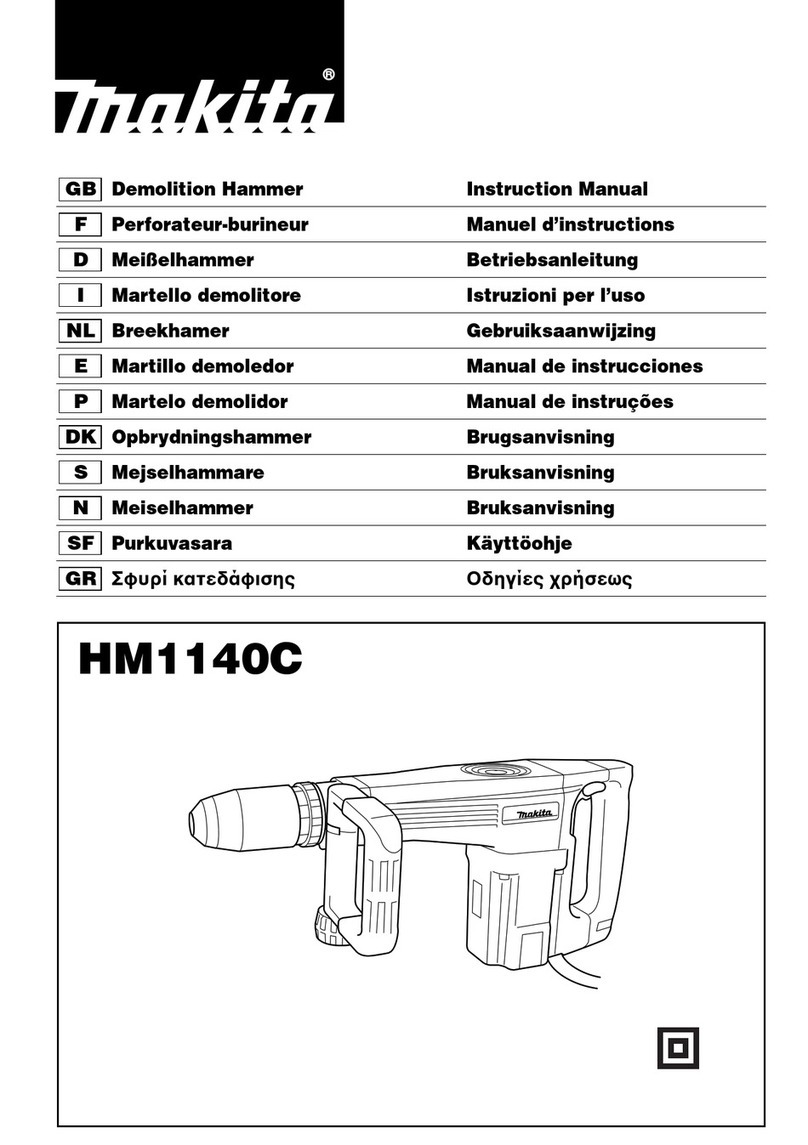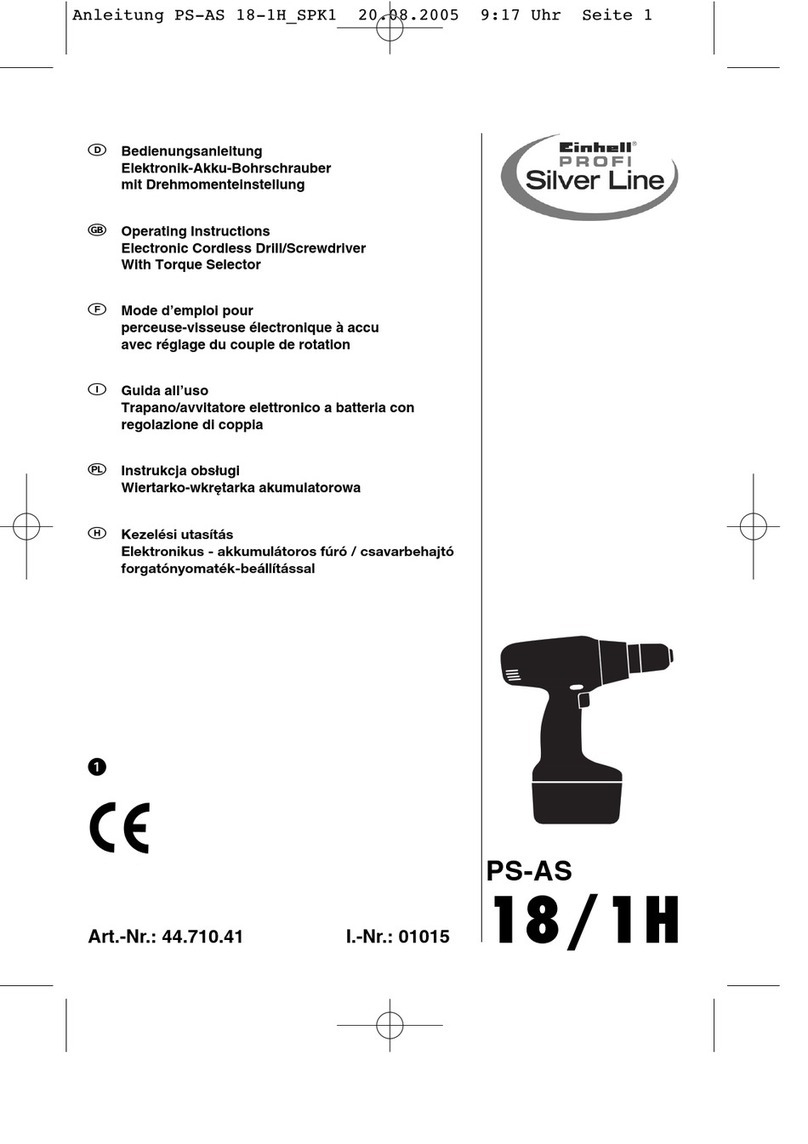Top Craft TAC-18/3 User manual

Users manual
Bedienungsanleitung
TAC-18/3
Cordless combi set
Jig saw, Triangular sander
and Cordless drill/driver
Akku-Kombisatz
Stichsäge, Dreieckschleifmaschine
und Akku-Bohrschrauber
Art. no./Art. Nr. CDM6083

02 Topcraft
Fig.1 Fig.2 Fig.3 Fig.4

Topcraft 03
CORDLESS COMBI SET
The numbers in the following text correspond to the illustrations on page 2.
Always read the entire instructions for this electrical appliance carefully before
using it. This will enable you to better understand your product and to avoid
any useless risks. Keep this handbook in a safe place for future reference.
Contents
1. Safety instructions
2. Charger
3. Jigsaw
4. Triangular sander
5. Cordless drill/driver
6. Maintenance
1. SAFETY INSTRUCTIONS
List symbols
The following pictograms are used in this manual and on the machine:
Attention: Risk of damage to material or body.
Indicates electrical shock hazard.
This is in accordance with essential safety requirements of the applicable
European directives.
Class II equipment- Double insulation – Grounding is not necessary.
The safety transformer is not dangerous in the event of failure.
Thermic protection 130°C.
For Inside use only.
Cadmium: Do not throw away.
GB

04 Topcraft
Cadmium: Do not throw away.
Dispose of any defective electronics or electrical component in a suitable
recycling center.
Do not incinerate.
Do not use at temperatures higher than 40°C.
Do not use in the rain.
General safety instructions
Warning! Read the following instructions carefully. The non-observance of these
instructions can result in electric shock, fire, and/or other serious injuries. The term
“electrical appliance” mentioned in all the warnings below refers to an electrical appliance
which plugs into electrical power (with an electric cable) or to an electrical appliance
(without wire) functioning with the help of a battery/batteries. Keep these instructions in a
safe place.
1) Work place
a. Always take care to keep your workspace clean and well lit. Badly arranged and dark
spaces can cause accidents.
b. Do not use the electrical appliance in environments with a risk of explosion, such as
in the presence of flammable liquids, gas, or particles. The electrical appliance
causes sparks which can ignite flammable substances.
c. Take care to keep away from children and others who could be distracting while using
the appliance. Distractions can make you lose control of the appliance.
2) Electric safety procedures
a. The plugs of the electrical appliance must be connected to the corresponding wall
sockets. Never modify the plugs in any way, doing so can cause electric shock. Do
not use adaptors which ground the electrical appliance.
b. Avoid direct contact with grounded surfaces like drains, radiators, cooking appliances
and refrigerators. The risk of electric shock increases if your body is in contact with
grounded surfaces.
c. Do not use electric tools in rainy or wet environments. If water gets into an electrical
appliance, the risk of electric shock will increase.
d. Do not abuse the cord. Never use the cord to transport, draw, or disconnect the
electrical appliance. Take care to keep the cord far away from heat sources, oils,
cutting edges, or moving parts. Damaged or intermingled cords increase the risk of
electric shock.
e. Only use a cord for outside use. The use of an outdoor cord reduces the risk of
electric shock. Always use the tool with a residual current circuit breaker.
GB

Topcraft 05
3) Personal safety
a. Remain attentive and focused on what you are doing. Use your common sense when
using this electrical appliance. Do not use the electrical appliance if you are tired or if
you are under the influence of drugs or alcohol. One moment of carelessness during
the use of this appliance can cause serious injuries.
b. Use protective gear. Always protect your eyes. Protective gear, such as a dust mask,
non-skid shoes, ear plugs, and safety helmet (when used properly), will reduce the
risk of injury.
c. Avoid accidental starting by ensuring that the switch is on the ‘Off’’ position before
connecting the apparatus. Transporting the electrical appliance with your fingers on
the switch, or connecting the appliance with the switch ‘’On’’ can cause accidents.
d. Withdraw the adjustment keys or the keys of adjustable screw before turning on the
electrical appliance. An adjustable screw or a key, left on a moving part of the
electrical appliance, can cause injuries.
e. Do not raise yourself up while using the appliance. Maintain a balanced position by
keeping your feet flat. This allows better control of the electrical appliance in
unforeseen situations.
f. Wear suitable clothes. Do not wear loose clothing or jewelry. Keep your hair, clothing,
and gloves far away from the moving parts.
g. If the appliance is provided with equipment to remove dust, ensure it is correctly
connected and used. The use of this equipment can reduce the risks from dust.
h. Use grips or a vice with screw to hold your work. This is safer and enables you to
have two free hands for operating the appliance.
4) Use and maintenance of an electrical appliance
a. Do not force the electrical appliance. Use the electrical appliance for its intended use
only. A correctly selected electrical appliance will ensure better work without a high
risk of danger.
b. Do not use the electrical appliance if the on/off switch does not function. An electrical
appliance which cannot be controlled by the switch is dangerous and must be
repaired.
c. Disconnect the plug of the power supply unit before carrying out adjustments,
changing accessories, or storing the electric appliance. These preventive safety
measures will reduce the risk of accidentally starting.
d. Store electrical appliance out of the reach of children and do not let any person not
familiarized with the tool or its instructions use the electrical appliance. Electrical
appliances are dangerous in the hands of untrained users.
e. Maintain the electrical appliance properly. Check the alignment and the sequence of
the moving parts for conditions which can affect the operation of the electrical
appliance. In the event of damage, send the electrical appliance for repair before re-
using it. Many accidents are caused by poorly maintained electrical appliances.
f. Keep all cutting tools sharpened and clean. Cutting tools which are properly
maintained with sharpened blades are less likely to get blocked and are easier to
control.
g. Use the electrical appliance and its accessories, etc, in accordance with these
instructions for their intended use only. Failure to do so may result in injury. Take into
account the work conditions and the specific work which is to be carried out.
GB

06 Topcraft
h. Any damaged switch must be replaced by qualified customer service maintenance.
Do not use an electric tool without a properly functioning on/off switch.
i. Never leave an electrical tool (which is on) unattended. Always stop the tool and wait
until it is immobilized before moving away.
j. If the principal electrical cord is damaged, it must be replaced by a suitable cord. This
can be obtained from the manufacturer or from the manufacturer’s customer service.
The main electrical cord must be replaced by the manufacturer, customer service, or
a person having equivalent qualifications.
5) Using and looking after the battery tools
a. Ensure that the switch is in the “off” position before inserting the battery. Inserting a
battery into a tool which is turned “on” can cause accidents.
b. Recharge the battery only with the charger specified by the manufacturer. A charger
adapted to a certain battery can cause a fire if used with a different battery.
c. Use each tool only with the battery designed for it. The use of any other battery can
cause injuries and fire.
d. When a battery is not in use, keep it away from metallic objects such as coins, keys,
nails, screws, and other small metal objects. A short-circuit between the terminals of
the battery can be the cause of burns or fire.
e. In extreme circumstances, liquid can spill out of the battery; avoid any contact. In the
event of accidental contact, rinse thoroughly with water. In the event of contact of the
liquid with the eyes, consult a doctor. Liquid which spills from a battery can cause
irritations or burns.
6) Maintenance
a. Please go to a qualified technician for repairs.
b. Caution! There is a risk of injury if you use additional accessories or tools others that
those recommended in this handbook. Use only spare parts of origin.
Special safety instructions
• The batteries provided are, rechargeable with Nickel-Cadmium of 18 volts (15
elements of 1,2 volts). When they can no longer be recharged, they must be replaced
with identical batteries (Ask customer service).
• A dead battery should not be thrown away, nor incinerated. See the paragraph on
recycling for disposal method.
• Do not insert a non-rechargeable battery in the charger.
• Disconnect the charger after charging is completed.
• Do not cover the battery during charge.
• Keep the batteries away from shocks, moisture, freezing, heat, or fire, as there is a
danger of explosion.
• Do not put the battery on a radiator, or expose it to the sun for a long time.
• Let the battery cool down after use before charging.
• When the batteries are out of their housing, protect the external contacts in order to
prevent short-circuiting due to a metallic bridge.
A short-circuit can generate a very strong current. This can cause overheating,
explosion of the battery, and other fire hazards
GB

Topcraft 07
• Do not continually use the fast charge option (model equipped with the fast charging
option). Do not recharge after using it for only a short time.
• Never let the batteries discharge completely. Recharge them from time to time if the
appliance is inactive for a long period of time.
• Fully charge a new battery before use.
• Bad storage or charge conditions will cause damage to the batteries. Always respect
the recommended charging times.
• Protect the charger against moisture. It should be only used in dry locations.
• The charger TACL-18/3 should be used exclusively to charge battery of type TACB-18.
• The ventilation openings of the charger must always be clear.
• If the electrical cord of the charger is damaged, it must be replaced by the
manufacturer, customer service, or a person of similar qualification, in order to avoid
danger.
Never use the charger to charge normal batteries.
2. CHARGER
Technical specifications
The level of protection against electromagnetic disturbances and the level of immunity are
in conformity with the European directives.
Charge a battery
• Check for the absence of metallic objects in the battery compartment of the charger.
• Insert the battery to be charged in the charger, checking the polarities. The poles of
the charger and the battery are located by the signs + and -.
• Check that the voltage of the power source is the same as indicated on the
identification plate of the charger.
Note: Before every use, check the state of the charger, from its plug to its cord. If it is
defective or damaged, the charger must be discarded or repaired by a qualified person.
• Connect the plug of the charger to a wall outlet.
• When charging has started the red indicator light will appear.
• When the battery is completely charged, the green indicator light will appear. The
charge must be stopped.
Supply voltage 230 V~
(alternate) 50 Hz
Output voltage 18 V (continuous)
Assigned power 70 W
Assigned output current 2 A (continuous)
Time of recharge 1h
GB

08 Topcraft
• It is normal for the battery and the charger warm up slightly during the charge:.
• The time of charge is approximately 1 hour.
• At the end of the charge, disconnect the charger and extract the battery.
Inserting and removing batteries
Verifies that the outside surfaces of the battery and the selected tool are clean
and dry before connecting a battery.
• Make sure that the On/Off switch is Off (for the drilling machine, the direction selector
must be in middle position).
• Insert the battery in the tool, ensuring that the polarities are aligned. A click will be
heard when the battery is correctly inserted in the bottom of the housing.
• To take out the battery, press on the buttons located on both sides of it. Remove the
battery by drawing it in the axis from its housing.
3. JIGSAW
Technical specifications
• The level of protection against electromagnetic disturbances and level of immunity are
in conformity with the European directives.
• When the acoustic pressure exceeds the value of 85 dB (A), it is necessary to wear
individual ear plugs or other ear protection devices.
Use of the apparatus
• The jigsaw should be used only for cutting materials such as wood, plastic, or thin
metal sheets.
• Never use your hand to remove the chips or wood residues. Switch off the machine
and wait for the blade to completely stop before performing this task.
• Before beginning work, check for the presence of nodes, points, or dangerous
deposits. Remove if necessary.
• Pay attention to the wood or material that falls: remain concentrated at the end of the
cut.
Supply voltage 18V continuous
Capacity battery 1.3 Ah
Autonomy 1h
Number of movements of the blade 1700/min
Maximum cutting depth in wood 50 mm
Maximum cutting depth in metal 3 mm
Angle of adjustable cut 0 to 45°
Pressure level acoustic (Lpa) 81.1 dB (A)
Level of power acoustic (Lwa) 92.1 dB (A)
Level of vibrations 2.606 m/s2
GB

Topcraft 09
• Respect the authorized thickness maximum of materials.
• During the cutting of a wall or ground, make sure there are no electric cables in the
vicinity. Always hold the saw by its plastic body in order to avoid risk of electric shock
in the event of cutting an electric cable.
• Wait for the blade to completely stop before removing it from the material.
• Always lower the transparent protection during work.
Immediately stop the saw in the following cases:
• Defective switch.
• Abnormal sparks at engine level.
• Smoke or odor coming from a burning insulator.
Choice of a blade
The jigsaw is provided with three blades, each one having different teeth sizes. The profile
and the size of tooth vary according to the material to be cut. Fine teeth will give a regular
and precise cutting. Use a narrow profile if you wish to saw curves or, for example, cut out
figures.
To select the appropriate blade, proceed as follows:
• Initially test a blade with larger teeth.
• If you do not obtain a regular and precise cutting, test a thinner blade.
• For plastic, aluminum, and steel, always use a blade with fine teeth.
In general, you work more quickly, but with less precision, by using a blade with bigger
teeth than a blade with fine teeth. To obtain optimal results, always make sure that the
blade is well sharpened. This jigsaw is appropriate for all the saw blades commercially
available.
Assembly/Disassembly of a blade
Fig.2
During the assembly or the disassembly of the blade, the jigsaw should not be able to
start accidentally. It is thus important to withdraw the battery during this operation.
For the assembly of a blade, follow these instructions:
• Take the small hexagonal key provided and loosen the screws on the blade holder.
• Insert the chosen blade by pushing it in the bottom of its housing.
• Strongly tighten the screws, while ensuring that the blade is positioned correctly
against the guide roller.
For disassembling, proceed in reverse way of the assembly. After the assembly of a
blade, but before using the tool, turn it on for approximately 30 seconds. Take care to stay
clear of the blade. If the speed slows or abnormal vibrations occur, make sure the blade is
not defective and/or it is assembled correctly.
Periodically lubricate the guiding rollers, particularly during the cutting of synthetic material
or metal sheets.
GB

10 Topcraft
Adjustment of the cut angle
Fig.3
The adjustment of the cut angle must be done while the battery is disconnected.
It is possible to perform cuts at an angle of 0° to 45° by inclining the table of support to
the right or left-hand side.
To regulate the slope:
Using the Allen wrench provided, loosen the six sided screws located under the base,
then push the base forward and make it swivel to the right or to the left according to the
desired angle, then re-tighten the screws. The following angles are indicated on the scale
printed on the base: 0°, 15°, 30°, and 45°.
Adjustment of the pendular motion
The adjustment of the pendular motion must be done while the battery is disconnected.
The pendular motion gives the tool a higher degree of accuracy at the time of the cut and
improves the output. The blade undergoes a double movement: movement from top to
bottom and pendular from the front to the back.
To modify the pendular motion:
press on the selector placed on the left side of the machine, turning it to the desired
position. The adjustment of the pendular motion depends on many factors: speed,
materials, type of cut, etc. It is recommended to test the cut.
The following adjustments are recommended:
• Position 0: Metals; pressed or curved materials.
• Position 1: Plastics and plywood.
• Position 2 or 3: Tender wood and panels of masonry such as plasterboards.
Starting
Before connecting the battery, check the assembly of the blade and the base of the
support carefully. Also check the operation of the On/Off switch: it must return freely to the
off position as soon as it is released. To start the jigsaw, press initially on the safety button
on the left side of the handle, then on the On/Off switch. To stop, release the switch.
Using recommendation
After starting the saw, wait until it reaches its normal mode, then place the base of support
on the part to be cut out, and push the saw forwards gradually. It is advised to trace a line
where you want to cut in order to obtain a straight cut. In the case of curved cuts, adopt a
slower speed of cutting.
The saw is provided with a dust extractor entry. For your health, we recommend you to
connect a system of aspiration to it. That will also make it possible to release the line of
cut during work.
While working, firmly put the base of support of the saw on the part to be cut
out in order to avoid rupturing the blade.
GB

Topcraft 11
4. TRIANGULAR SANDER
Technical specifications
The level of protection against electromagnetic disturbances and the level of immunity are
in conformity with the European directives.
Use of the apparatus
This sander is designed to work with wood. The wood dust created by the grinder can be
dangerous for the user.
We recommend you the following precautions:
1. Connect equipment for dust extraction on the extraction opening located for this
purpose on the top of the sole (at the back).
2. Wear a dust protection mask during work.
• Wear ear protection equipment and safety goggles.
• This sander is for finishing. Its triangular form makes it possible to reach particularly
difficult places.
Do not use it for rough-hewing. Do not exert excessive pressure on the tool during
sandpapering. Change abrasive paper as soon as it is worn out or damaged.
Stop the grinder immediately if the following occurs:
• Abnormal heating of the body of the sander
• Defective switch.
• Abnormal sparks on the level of the engine.
• Smoke or odor coming from a burning insulator.
Fixing the abrasive paper
• Use abrasive sheets that have the same dimensions as the sole of the sander (90 x
90 x 90 mm). These sheets must be perforated (6 holes).
• The sole of the sander as well as the interior face of abrasive paper are equipped
with Velcro, thus making it possible to change paper easily.
• Place abrasive paper on the sole of the sander so that it is entirely covered with the
holes of the sole correspond with the holes of paper.
Supply voltage 18V continuous
Battery Capacity 1.3 Ah
Autonomy 1h
Number of oscillations of the sole 6000/min
Size of the sole 90 x 90 x 90 mm
Pressure level acoustic (Lpa) 81.0 dB (A)
Level of power acoustic (Lwa) 95.0 dB (A)
Level of vibrations 3.4 m/s2
GB

12 Topcraft
• During sandpapering, if the paper shifts, stop the tool and correct the paper before
resuming work.
Starting
• Ensure that abrasive paper is correctly positioned.
• Connect the battery (18 volts) to the sander
• Press on the On/Off switch to start.
• Relax the switch to stop the sander
Sandpapering
Sand by using small circular motions. Sandpapered surface will have a uniform and
consistent appearance. The way the tool is held is of no importance. It is not necessary to
exert any particular pressure.
Replacement of the sole
When the sole is worn out or damaged, it must be replaced. Use only spare parts of
origin: consult the retailer.
For the replacement:
• Remove abrasive paper.
• Unscrew the 3 Phillips screws under paper.
• Remove the sole and replace it with a new sole.
• Tighten the 3 screws firmly.
5. CORDLESS DRILL/DRIVER
Technical specifications
The level of protection against electromagnetic disturbances and level of immunity are in
conformity with the European directives.
Assembly of a drill or a bit
• Make sure that the battery is not in place. Remove it if required, by pressing the
buttons on each side of the body.
• This drilling machine is equipped with an auto tightening chuck which allows for the
opening and the closing of the bits without the use of a key.
Supply voltage 18V continuous
Battery Capacity 1, 3 Ah
Autonomy 1h
2 speeds 0-400/min and 0-1150/min
Chuck capacity 10 mm
Maximum diameter of drilling in metal 10 mm
Sound pressure level (Lpa) 75 dB (A)
Sound level of power (Lwa) 88 dB (A)
Level of vibrations 2,5 m/s2
GB

Topcraft 13
Turn the ring of the chuck counter-clockwise in order to open the bits.
• Insert the drill or the bit chosen until it touches the bottom of the chuck.
• Close the chuck clockwise while turning the ring. During this operation, make sure
that the drill or the tip bit is correctly centered compared to the axis of the chuck.
• Make sure that the drill or the bit is sufficiently tight before beginning work.
Attention! During the changing of a tool, installation of the battery, and
transportation or storage of the drilling machine, keep the rotation direction
switch in the middle position (locking of the trigger).
Remove the battery before working on the drilling machine,
Starting
• Choose the rotation direction needed, using the reverser located above the On/Off
switch.
• Drilling machine will not function if the reverser is in the middle position.
• Clock wise direction must be used for the operations of drilling or screwing.
• Counter-clockwise direction must be used for the operations of unscrewing.
• Choose the couple desired using the ring located before the chuck.
• A weak torque must be selected for the operations of screwing in a soft material or
when small screws are used.
• A high torque must be selected for operations of screwing in a hard material or when
large screws are used.
• If the adjustment of the torque is correct, the machine stops automatically when the
screw is level with the material.
• To obtain a good adjustment, proceed by successive tests. Always start with a weak
couple and increase it gradually, until obtaining the desired result.
• For the operations of drilling, place the ring on the position “drill”.
• Choose the speed 1 or 2 using the selector on the top of the machine:
• Position 1 = Slow speed
• Position 2 = Fast speed
• Insert the battery correctly in its housing. Begin work while pressing on the On/Off
switch.
• This drilling machine is equipped with an electronic switch making it possible to select
the speed best adapted to the specific work you carry out. While pressing slightly on
the trigger, the drilling machine turns slowly. By increasing the pressure on the trigger,
speed increases. It is recommended to always start with a low speed.
• Never change the direction of rotation when the engine is turning.
• To stop the drilling machine, release the On/Off switch: the chuck is slows and
immobilized instantaneously.
6. MAINTENANCE
• Take care of your tools by cleaning regularly. This will ensure a perfect operation and
a long working life.
• During utilization and at the end of work, carefully clean the machine’s ventilators
• Only clean with a warm, damp rag and a flexible brush.
GB

14 Topcraft
• Do not spray or wet the tool.
• Do not use detergents or solvents, as this can damage the machine irreparably. The
plastic parts can be easily damaged by chemical agents.
• For repairs and maintenance not specified in these instructions, go to an approved
customer service center.
• The charger does not require any particular maintenance.
• Oil jigsaw rollers regularly.
The tools do not require any further lubrication.
• Carefully store the tools, the batteries, and the charger in the case provided.
• In the event of breakdown: consult the retailer.
Recycling
Protect the environment by following local environmental standards.
Do not throw packaging in the garbage. If you can, re-use it. When the machine cannot be
used any more or cannot be repaired, disassemble and dispose of accordingly: all the
plastic components have initials which identify the materials of which they are made off.
That is useful for the future recycling of the tool.
Attention! : Elimination and recycling of the batteries of Nickel-Cadmium. When
disposing of the battery, it is necessary to do so in a safe way. In order to
protect the environment, the batteries should not be thrown in the household
refuse, nor incinerated: they contain dangerous materials. It will be necessary
to bring them to the recovery centre nearest to your residence: consult your
retailer.
Warranty
See conditions of warranty on the included warranty chart.
GB

Ferm 14
CE DECLARATION OF CONFORMITY (GB)
We declare under our sole responsibility that this
TAC-18/3, Cordless combi set
is in conformity with the standard norms and the following standardised documents
EN60335-1: 2002 + A1 + A11, EN60335-2-29: 2004, EN50366: 2003,
EN55014-1: 2000 + A1 + A2, EN55014-2: 1997 + A1, EN61000-3-2: 2000 + A2,
EN61000-3-2: 1995 + A1 + A2 + A14, EN61000-3-3: 1995 + A1 + A2,
EN60745-1: 2003 + A1, EN60745-2-1: 2003, EN60745-2-2: 2003, EN60745-2-4: 2003,
EN60745-2-11: 2003
In accordance with regulations,
98/37/EC, 2006/95/EC, 89/336/EEC, 2002/95/EC, 2002/96/EC
Of 01-10-2007
ZWOLLE NL
J.A. Bakker - van Ingen J. Lodewijk
CEO Ferm BV Quality Manager Ferm Global
It is our policy to improve our products continuously and consequently we hold the right to
change the instructions of the products without prior warning.
Ferm BV • Lingenstraat 6 • 8028 PM • Zwolle Netherlands
GB

16 Ferm
AKKU-KOMBISATZ
Die nachfolgenden Textangaben beziehen sich auf die Abbildungen auf Seite 2.
Lesen Sie Bedienungsanleitungen für elektrische Geräte vor dem Gebrauch
immer aufmerksam durch. Sie ermöglichen sich damit ein besseres
Verständnis des Produkts und können unnötige Gefahren vermeiden.
Bewahren Sie die Bedienungsanleitung zum Nachschlagen auf.
Inhaltsverzeichnis
1. Sicherheitshinweise
2. Akku-Ladegerät
3. Stichsäge
4. Dreieckschleifmaschine
5. Akku-Bohrschrauber
6. Wartung
1. SICHERHEITSHINWEISE
Verzeichnis der Symbole
Die nachfolgenden Piktogramme werden in den jeweiligen Anleitungen und auf den
Maschinen verwendet:
Vorsicht: Gefahr von Sachschäden und Körperverletzungen.
Gefährliche elektrische Spannung.
Entspricht den erforderlichen Sicherheitsanforderungen der zutreffenden
europäischen Direktiven.
Gerät der Klasse II – Doppelte Isolation – Eine Erdung ist nicht notwendig.
Sicherheitstransformator zum Schutz bei Fehlfunktionen.
Thermoschutzsicherung 130°C.
Nur für den Gebrauch in Räumen.
Cadmium: Nicht in den Hausmüll entsorgen.
D

Ferm 17
Cadmium: Nicht in den Hausmüll entsorgen.
Alle elektronischen und elektrischen Geräte sind von Ihnen getrennt und an
geeigneten Recycling-Annahmestellen abzugeben.
Nicht ins Feuer werfen.
Nicht über Temperaturen von 40°C verwenden.
Nicht im Regen verwenden.
Allgemeine Sicherheitshinweise
Warnung! Lesen Sie die Anleitungen aufmerksam durch, um ernsthafte Verletzungen,
Stromschläge und Brände zu vermeiden. Der in den nachfolgenden Warnhinweisen
verwendete Begriff „Elektrisches Gerät“ bezieht sich auf ein elektrisches Gerät, das an ein
Stromnetz (mit Hilfe eines Netzkabels) angeschlossen ist, oder auf ein Gerät (drahtlos),
das mit Batterie betrieben wird. Befolgen Sie alle Anleitungen.
1) Arbeitsplatz
a. Achten Sie darauf, dass Ihr Arbeitsplatz immer sauber und gut beleuchtet ist.
Unordentliche und unübersichtliche Umgebungen können Unfälle verursachen.
b. Verwenden Sie elektrische Geräte nicht in Umgebungen, in denen Explosionsgefahr
besteht, wie z.B. in der Nähe von brennbaren Flüssigkeiten, Gas oder Partikeln.
Elektrische Geräte können Funken verursachen, die zu einer Explosion führen
können.
c. Achten Sie darauf, elektrische Geräte nicht in der Nähe von Kindern oder anderen
Personen zu verwenden. Sie können durch Ablenkungen die Kontrolle über das Gerät
verlieren.
2) Sicherheitsmaßnahmen beim Umgang mit elektrischen Geräten
a. Die Stecker von elektrischen Geräten müssen an eine geeignete Steckdose
angeschlossen werden. Nehmen Sie keine Änderungen am Gerätestecker vor.
Verwenden Sie keine Adapter, die das elektrische Gerät mit der Erde (der Masse)
verbinden. Unveränderte Stecker, die an einer geeigneten Wandsteckdose
angeschlossen sind, verringern das Risiko eines Stromschlags.
b. Vermeiden Sie den direkten Kontakt mit geerdeten Oberflächen wie dem
Leitungsnetz, Heizgeräten, Kochherden und Kühlschränken. Es besteht
Stromschlaggefahr, wenn Ihr Körper geerdet wird oder mit der Masse in Berührung
kommt.
c. Verwenden Sie elektrische Werkzeugmaschinen nicht in Umgebungen mit erhöhter
Feuchtigkeit. Es besteht Stromschlaggefahr, wenn Wasser in ein elektrisches Gerät
eindringt.
D

18 Ferm
d. Verwenden Sie das Kabel niemals zum Transportieren, Ziehen oder Ausschalten von
elektrischen Geräten. Achten Sie darauf, das Kabel nicht in der Nähe von
Wärmequellen, Öl, scharfen Kanten oder Antriebsteilen zu verlegen. Beschädigte
oder verknotete Kabel erhöhen die Stromschlaggefahr.
e. Wenn Sie ein Gerät im Freien verwenden, benutzen Sie nur ein Verlängerungskabel,
das für diesen Zweck geeignet ist, um die Gefahr eines elektrischen Schlages zu
verringern. Verwenden Sie Werkzeugmaschinen immer mit einer Abschaltvorrichtung.
3) Eigene Sicherheit
a. Seien Sie wachsam; achten Sie immer auf das, was Sie tun. Gehen Sie beim
Gebrauch von elektrischen Geräten mit Bedacht vor. Verwenden Sie keine
elektrischen Geräte, wenn Sie müde sind unter dem Einfluss von Drogen oder Alkohol
stehen oder Medikamente eingenommen haben. Ein Moment der Unachtsamkeit
beim Umgang mit elektrischen Geräten kann zu schweren Verletzungen führen.
b. Verwenden Sie Schutzausrüstungen. Schützen Sie immer Ihre Augen.
Schutzausrüstungen, wie z.B. eine Staubmaske, rutschfeste Schuhe, Gehörschutz
oder ein Schutzhelm können das Verletzungsrisiko verringern.
c. Vermeiden Sie ein versehentliches Starten der Geräte. Vergewissern Sie sich vor
dem Anschließen des Geräts, dass der Schalter auf Position „AUS“ steht. Verringern
Sie das Unfallrisiko, indem Sie Ihre Finger auf dem Ausschalter des elektrischen
Gerätes lassen, oder indem Sie das Gerät anschließen, wenn der Schalter auf
Position „AUS“ steht.
d. Entfernen Sie die Linierungsschlüssel oder die Schraubenschlüssel für die Einstellung
vor dem Einschalten eines elektrischen Geräts. Ein Schraubenschlüssel für die
Einstellung oder ein Linierungsschlüssel können zu Verletzungen führen, wenn sie auf
einem sich bewegendem Teil des elektrischen Gerätes belassen werden.
e. Stehen Sie nicht erhöht. Stehen Sie mit beiden Füßen auf dem Boden und halten Sie
Ihr Gleichgewicht. Somit können Sie in unvorsehbaren Situationen ein elektrisches
Gerät am besten kontrollieren.
f. Tragen Sie passende Kleidung. Tragen Sie keine lockere Kleidung oder Schmuck.
Halten Sie Ihre Haare, Kleidung und Handschuhe fern von sich bewegenden Teilen.
g. Wenn die Geräte für den Anschluss von Entsorgungsgeräten und die
Staubrückgewinnung geliefert werden, vergewissern Sie sich, dass die Rückseiten
richtig angeschlossen sind und genutzt werden. Die Verwendung solcher Geräte kann
die mit Schleifstaub verbundenen Risiken verringern.
h. Verwenden Sie zu Ihrer eigenen Sicherheit Klemmen oder einen Schraubstock, um
Ihre Werkstücke zu halten. Somit haben Sie beide Hände frei, um Ihre Maschine
einzuschalten.
4) Gebrauch und Wartung von elektrischen Geräten
a. Üben Sie keine Gewalt auf elektrische Geräte aus. Verwenden Sie elektrische Geräte
entsprechend dem Verwendungszweck. Ein richtig ausgewähltes elektrisches Gerät
garantiert ein besseres und sicheres Arbeiten, in einem dafür vorgesehenen
Rhythmus.
b. Verwenden Sie ein elektrisches Gerät nicht, wenn der Ein-/Ausschalter nicht
funktioniert. Ein elektrisches Gerät, das nicht über den Kontrollschalter gesteuert
werden kann, ist gefährlich und muss repariert werden.
D

Topcraft 19
c. Ziehen Sie den Netzteilstecker, bevor Sie Einstellungen vornehmen, Einzelteile
austauschen oder das elektrische Gerät bewegen. Diese Sicherheitsmaßnahmen
verringern das Risiko ungewollter Verletzungen.
d. Lassen Sie elektrische Geräte ausgeschaltet, wenn sie von Kindern getragen werden
und lassen Sie niemals Personen, die nicht mit dem Werkzeug oder dessen
Anleitungen vertraut sind, das Gerät bedienen. Eine Bedienung durch unerfahrene
Benutzer kann zu gefährlichen Situationen führen.
e. Warten Sie elektrische Geräte. Überprüfen Sie regelmäßig alle Einstellungen und
Verbindungen der angetriebenen Teile auf Schäden am Gerät sowie andere
Zustände, die die Funktionsfähigkeit des elektrischen Geräts beeinträchtigen können.
Lassen Sie elektrische Geräte bei vorhandenen Schäden reparieren, bevor Sie diese
wieder verwenden. Schlecht gewartete elektrische Geräte können Unfälle
verursachen.
f. Achten Sie darauf, dass die Werkzeugklingen scharf und sauber sind. Geschärfte
Werkzeugklingen sind weniger anfällig für Blockierungen und viel einfacher zu steuern.
g. Verwenden Sie unter Berücksichtigung der Arbeitsbedingungen und der
auszuführenden Arbeiten elektrische Geräte, Zubehör und Kabelschuhe, usw. nur in
Übereinstimmung mit den Anleitungen und dem für das elektrische Gerät bestimmten
Zweck. Die Verwendung von elektrischen Geräten für andere als die vorgesehenen
Anwendungen kann gefährliche Situationen verursachen.
h. Alle beschädigten Ausschalter müssen von einem qualifizierten Wartungsspezialisten
ausgetauscht werden. Verwenden Sie ein elektrisches Gerät nicht ohne Ein-/Ausschalter.
i. Lassen Sie elektrische Geräte nicht unbeaufsichtigt, wenn diese eingeschaltet sind.
Stoppen Sie das Gerät immer und warten Sie, bis es komplett still steht, bevor Sie
sich von dem Gerät entfernen.
j. Wenn das Netzkabel beschädigt ist, muss es durch ein geeignetes, spezielles Kabel
ersetzt werden. Dieses erhalten Sie beim Hersteller oder beim Kundendienst. Das
Netzkabel darf nur vom Hersteller, dessen Kundendienst oder einer Person mit der
entsprechenden Qualifizierung ausgetauscht werden.
5) Batteriebetriebene Geräte und deren Wartung
a. Vergewissern Sie sich, dass der Ausschalter vor dem Einlegen der Batterie auf
Position „AUS“ steht. Wenn Sie die Batterie in ein Gerät legen, dessen Schalter auf
Position „EIN“ steht, besteht erhöhte Unfallgefahr
b. Laden Sie die Batterie nur mit dem vom Hersteller bereitgestellten Aufladegerät. Es
besteht ein erhöhtes Brandrisiko, wenn Sie andere Batterietypen verwenden, als
solche für die das Aufladegerät ausgerüstet ist.
c. Verwenden Sie jedes einzelne Gerät nur mit dem Batterietyp, der für ihn bestimmt ist.
Es besteht Verletzungs- und Brandgefahr, wenn Sie andere Batterietypen verwenden.
d. Wenn Sie eine Batterie nicht verwenden, bewahren Sie diese auf, ohne Sie durch
Metallobjekte wie Büroklammern, Geldstücke, Schlüssel, Nägel, Schrauben und
andere Metallobjekte zu beschädigen. Kurzschlüsse an den Batterieklemmen können
Verbrennungen oder Brände zur Folge haben.
e. Vermeiden Sie Kontakt mit ausgelaufener Batterieflüssigkeit. Wenn Sie dennoch in
Kontakt mit der Flüssigkeit kommen, spülen Sie diese unter reichlich Wasser ab.
Wenn Ihre Augen mit der Flüssigkeit in Berührung kommen, suchen Sie umgehend
einen Arzt auf. Die aus der Batterie austretende Flüssigkeit kann Reizungen oder
Verbrennungen verursachen.
D

20 Topcraft
6) Wartung
a. Wenden Sie sich an einen qualifizierten Techniker, der Originalteile zum Reparieren
Ihres elektrischen Gerätes verwendet. Somit garantieren Sie eine sichere
Funktionsweise Ihres Werkzeugs.
b. Vorsicht! Wenn Sie andere als die in dieser Bedienungsanleitung empfohlenen
Zubehör- oder Ersatzteile verwenden, erhöht sich Verletzungsgefahr. Verwenden Sie
deshalb nur Originalersatzteile.
Spezielle Sicherheitshinweise
• Die mitgelieferten Batterien sind wieder aufladbare 18V Nickel-Cadmium Batterien (15
Elemente je 1,2V). Wenn diese nicht mehr aufgeladen werden können, müssen sie
durch Batterien mit den gleichen Eigenschaften ausgetauscht werden. Wenden Sie
sich ausschließlich an einen zugelassenen Kundendienst.
• Verbrauchte Batterien dürfen weder weggeworfen noch verbrannt werden. Informieren
Sie sich im
Abschnitt Recycling.
• Laden Sie nicht wieder aufladbare Batterien nicht mit diesem Ladegerät auf.
• Trennen Sie das Ladegerät nach dem Ladevorgang wieder vom Netz.
• Bedecken Sie die Batterie während des Ladevorgangs nicht.
• Schützen Sie die Batterien vor Aufprallen, Feuchtigkeit, Wärme oder Feuer:
Explosionsgefahr.
• Legen Sie eine Batterie nicht auf ein Heizgerät und setzen Sie sie nicht über einen
längeren Zeitraum Sonnenstrahlung aus.
• Lassen Sie eine Batterie, die aufgrund einer langen Nutzung heißgelaufen ist, vor
dem Ladevorgang abkühlen.
• Wenn die Batterien nicht in ihrem Gehäuse sind, schützen Sie die externen Kontakte,
um Kurzschlüsse aufgrund einer metallischen Brückenschaltung zu vermeiden.
Ein Kurzschluss kann einen dreimal so starken Stromfluss generieren und
damit die Überhitzung oder Explosion der Batterie verursachen. Es besteht
Brandrisiko.
• Nehmen Sie nicht mehrmals in Folge schnelle Ladevorgänge vor. (Die Bauart
ermöglicht ein schnelles Aufladen.) Laden Sie die Batterie nicht nach einer nur kurzen
Nutzung wieder auf.
• Achten Sie darauf, dass sich die Batterien nie ganz entladen. Die Wiederaufladezeit
verlängert sich, wenn der Bohrer längere Zeit ohne Anwendung aufbewahrt wird.
• Bevor Sie eine neue Batterie verwenden, laden Sie diese vollständig auf.
• Schlechte Lager- oder Ladebedingungen können die Batterien unwiderruflich
schädigen. Halten Sie die Ladezeiten immer präzise ein.
• Schützen Sie das Ladegerät vor Feuchtigkeit. Es darf nur in Wohninnenräumen und
in trockenen Räumen verwendet werden.
• Das Ladegerät TACL-18/3 darf nur für das Aufladen von Batterien des Typs TACB-18
verwendet werden.
• Die Lüftungsöffnungen des Ladegeräts müssen immer sauber und frei sein.
• Falls das Netzkabel des Ladegeräts beschädigt ist, muss es vom Hersteller, dessen
Kundenservice oder einer ähnlich qualifizierten Person ausgewechselt werden, um
Gefahrensituationen zu vermeiden.
D
Table of contents
Languages:
Other Top Craft Power Tools manuals
